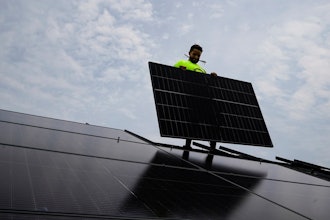This article originally appeared in the October 2013 issue of Food Manufacturing.
Interview with Stephen Rogers, Co-Founder, AMTek Microwaves
Industrial microwave systems can offer food processors unique benefits, including increased energy efficiency as well as precise process control.
Q&A: What are the benefits of choosing an industrial microwave system versus another thermal processing solution?
A: Using microwave energy for food processing offers many advantages over conventional thermal processing systems. Benefits include: instant on and off, less start up time, faster heating, high energy efficiency, smaller equipment footprint, precise process control and clean heat technology. Conventional methods of heating and drying do not compare to the efficiency of an industrial microwave system. Payback based on energy savings is variable; however, additional cost savings come from higher production speed, waste reduction and product quality.
Microwave heating technologies are unique in that heat is developed within the product itself. This is known as volumetric heating. It allows more uniform heating at an accelerated rate. For example, in conventional drying, heat is transferred to the surface of the material by conduction, convection or radiation and into the interior of the material. Moisture is initially flashed off from the surface and the remaining water diffuses to the surface. This is often a slow process and the diffusion rate is limited, requiring high external temperatures to generate the temperature differences required.
Rather than heating from the surface through to the center, microwave dryers heat throughout the material. Heat can be applied deep within a mass at lower drying temperatures without waiting for the heat to “soak” through. As a result there is significant operational efficiency such as yield gains, increased throughput, labor reductions, reduction in heat load in the plant, reduced maintenance costs and reduction in product fouling. A short processing time and lower temperatures are desirable in terms of less nutritive loss in microwave process foods.
Q: What services does AMTek provide to food processors regarding microwave systems and support?
A: We offer product testing and design assistance to customers considering the purchase of a microwave system. Once a processor decides to purchase a system, we commission the system with startup, debugging and operator training.
For processors with existing systems we provide technical support on our equipment, as well as industrial microwave systems from other manufacturers, 24 hours a day, seven days a week. We carry a full line of service parts inventory. We also provide several optional upgrades to enhance the operation of the equipment. These robust assemblies have been designed as cost-effective kits to help minimize system downtime and maximize plant production.
Q: For which food products and processes does a microwave system work best?
A: The use of microwaves for food processing is continuously developing worldwide. The most widespread use of industrial microwave processing in the food industry is for applications such as boost heating, tempering, drying and cooking. Microwave systems can perform many of the functions of conventional ovens, but typically are used where speed and unique heating requirements are dictated. Microwave processing has been successfully applied on an industrial scale to cooking of meat and bacon, tempering of meat, poultry, fish, vegetables and fruit, drying of snacks, vegetables and soybeans, and pasteurizing of ready meals and pasta.
Food products prone to case hardening, in many cases, are optimal candidates for microwave drying. The high susceptibility of water to microwave energy means that the drying process is self-equalizing. Areas of high moisture content draw more power than dryer ones. This is extremely useful for moisture leveling and conditioning of grains, as well as foods like cookies and crackers.
To continue reading the rest of the Q&A, click here to visit our partner publication, Food Manufacturing.























